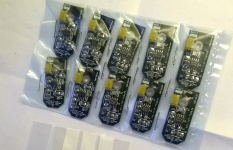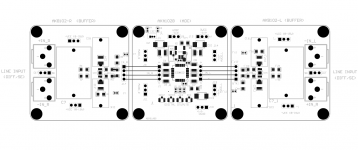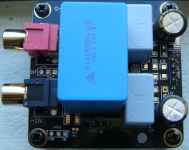Hi ... I don't know actually. I haven't yet got around to test the USBPAL with an AD or DA -
Jesper
I have just re-read the notes I took at the time I spoke to Rigisystems.
The potential issue is with driver licencing not the SDK.
This is an extract from the Thesycon evaluation kit.
The free evaluation version of the TUSBAudio device driver
supports all features of the full version. The evaluation version
works for an interval of 60 minutes without any limitation.
After that interval has expired the driver inserts a beep tone
every five minutes to all input and output audio channels.
The evaluation interval can be restarted by unplugging the
device and plugging it in again.
So you are currently using the TUSBAudio Spy Tool to look for dropouts in the USB transfer ?
Cheers. Dean.
Last edited:
Hi Dean,
No, the USBPAL's software itself has a monitoring function that indicates if there were any data dropouts. It's associated with the latency setup so that it's possible - depending on one's need for a low round-trip latency - to reduce the latency to the lowest possible without data dropouts. It's really quite simple IMHO - also to mix the individual channels going in and out. BTW there's an example of what the user interface looks like here (although without the latency, sample rate etc. settings):
USB Audio - RigiSystems AG
See "user interface beispiel" (if you don't already know about this).
Best regards,
Jesper
So you are currently using the TUSBAudio Spy Tool to look for dropouts in the USB transfer ?
No, the USBPAL's software itself has a monitoring function that indicates if there were any data dropouts. It's associated with the latency setup so that it's possible - depending on one's need for a low round-trip latency - to reduce the latency to the lowest possible without data dropouts. It's really quite simple IMHO - also to mix the individual channels going in and out. BTW there's an example of what the user interface looks like here (although without the latency, sample rate etc. settings):
USB Audio - RigiSystems AG
See "user interface beispiel" (if you don't already know about this).
Best regards,
Jesper
Precision Buffer
Matching Buffer, one for each channel of the ADC. Requires +/-9V to +/-12V supplies.
BUFFER is required and will be available as a separate module (PN:AKB102) ...
Matching Buffer, one for each channel of the ADC. Requires +/-9V to +/-12V supplies.
Attachments
What is the gain?
//
Default Av=1, adjustable <1 to match line levels
No print indicating + / - on out.... ?
Is that a RCA for In+ and a RCA for In- on the buffer input?
The adjustable gain - how is that accomplished control wise and how is it implemented?
//
J1 is the output. "GND, +, -, GND" are marked on board and matches the ADC inputs
Input connectors are RCA. Supplied but not mounted. The is also a 2-way header underneath the RCA if this is preferred. For single-ended sources, connect to the Red Input only and set the jumper to "SE". For balanced source connect to both inputs +/- and set jumper to "DIFF"
Buffer Av=1, set by resistor on board with thru hole pads for adding shunt resistors to trim gain (attenuate only) if required to match line levels.
Design is still being reviewed, Adding a few more tweaks to improve performance-being the front end this is critical. All precision components and PP film caps.
There will not be a GB but those who have purchased the ADC boards will be notified when ready for ordering.
Level meter on the digital side? How would one accomplish such a thing? I'm building this for recordings with mic.
//
There is only a clip detect flag on the 9102 chip and this via software (i2c) monitoring only
Matching Buffer, one for each channel of the ADC. Requires +/-9V to +/-12V supplies.
All tests completed and looking good.
For more details and ordering information please go to my webpages
I exchanged 5 (3 1,2v and 2 3,6v) out of 7 stabs on my AKD12P and the results is amazing. The resulting stability of the soundscape and resolution of fine musical detail during busy high level passages is nothing but astounding. Looking fwd using these to build my AD with the same concept using trafo on the input. Nice work Acko!
I exchanged 5 (3 1,2v and 2 3,6v) out of 7 stabs on my AKD12P and the results is amazing. The resulting stability of the soundscape and resolution of fine musical detail during busy high level passages is nothing but astounding. Looking fwd using these to build my AD with the same concept using trafo on the input. Nice work Acko!
Excellent! Thanks for the feedback.
See if you can improve the performance further with the tweaks as indicated in the user's manual (for the AKR75-3.6V types)
Hi acko
Any news on the MCU yet
This is in the works. Concept as proposed in the manual. Hardware similar to DAC MCU so consider this done. As for the firmware I prefer to get this done professionally using C code rather than using a patchwork of open source scripts. Dev Costs ~$5K and even if shared may be too high for many given the small user base. So looking around for cheaper plans and will advise.
I will update the manual soon with some register information so if you can do I2C script programming using Arduino etc that would be a good alternative
Last edited:
This is in the works. Concept as proposed in the manual. Hardware similar to DAC MCU so consider this done. As for the firmware I prefer to get this done professionally using C code rather than using a patchwork of open source scripts. Dev Costs ~$5K and even if shared may be too high for many given the small user base. So looking around for cheaper plans and will advise.
I will update the manual soon with some register information so if you can do I2C script programming using Arduino etc that would be a good alternative
Hi, where can I get my hands on the manual?
Regards
Hi, where can I get my hands on the manual?
Regards
Manual supplied to those who bought the ADC module. If you have not received it please email, re: your order.
Manual supplied to those who bought the ADC module. If you have not received it please email, re: your order.
Done
Regards
- Status
- This old topic is closed. If you want to reopen this topic, contact a moderator using the "Report Post" button.
- Home
- Source & Line
- Digital Line Level
- ADC using ES9102/9112


